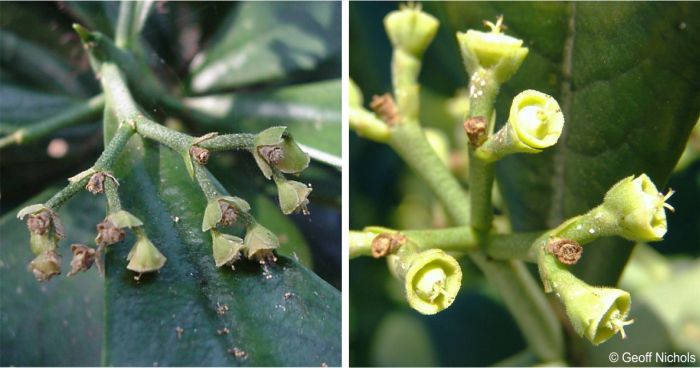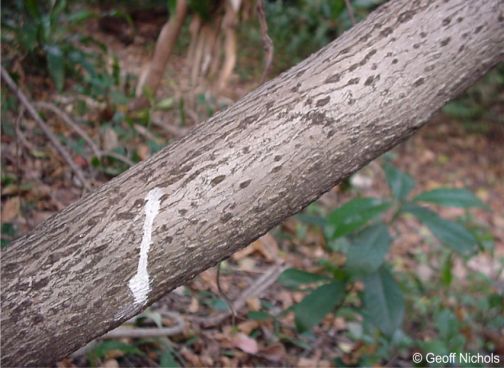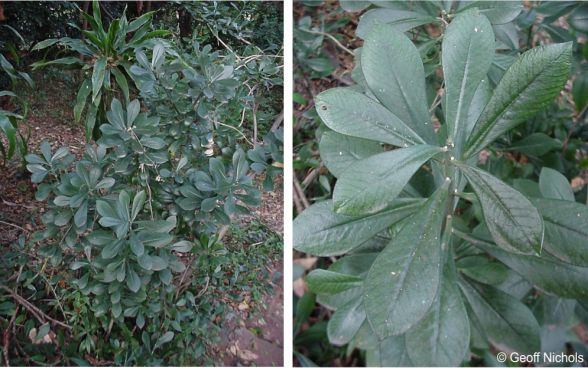Euphorbia cupularis
Euphorbia cupularis Boiss. (= Synadenium cupulare (Boiss.) L.C.Wheeler)
Family: Euphorbiaceae
Common names: dead-man’s tree, crying tree (Eng.); dooiemansboom, gifboom (Afr.); umdlebe, umdletshane (isiZulu); sidlejane (isiSwati); mulamba-noni (Tshivenda)
SA Tree No: 357.1
Introduction
Euphorbia cupularis is a compact succulent shrub or small tree characterized by multiple stems and a rounded growth habit. Its striking emerald-green foliage adds to its appeal. While this plant has a history of traditional medicinal use for addressing diverse ailments, it is important to note that, akin to other Euphorbias, its sap possesses potent toxicity. Contact with the sap can result in temporary vision impairment and skin blisters.

Description
Description
Euphorbia cupularis is a deciduous, succulent shrub or small tree that has a spreading growth habit, reaching heights of 2-4 m and occasionally reaching 5 m. Its form is rounded, characterized by multiple stems. The main stem features a smooth and grey-coloured bark, glossy green branchlets and noticeable leaf scars. Leaves are simple, alternate, egg-shaped, 60-150 mm in length and 20-60 mm in width, fleshy and usually clustered at the ends of branchlets. The upper surface of the leaves showcases a rich dark green to purplish-green, while the underside exhibits a lighter green tone with prominent purple veins. The leaves taper to a pointed apex with a drip tip and have a narrow base. Their margins are smooth and uninterrupted. Leaf petioles are short, 10 mm long, and red. Flowers are small and cup-shaped, forming a flower head approximately 70 mm in size. These yellow blooms appear at the terminal ends of the branchlets during late summer and early autumn, specifically from February to May. As the season progresses, the plant produces small rounded capsules, about 5 mm in diameter, which turn brown as they mature and split open between April and August, releasing their seeds.

Conservation Status
Status
According to the Red List of South African plants, the conservation status of this plant is Least Concern (LC).
Distribution and habitat
Distribution description
In South Africa, this species is mainly distributed in KwaZulu-Natal, Mpumalanga and the extreme south of Limpopo. It also occurs in Eswatini and Mozambique. It is found in bushveld, thicket, sand forest and coastal bush. It grows well in arid and semi-arid regions with dry, sandy soil. These areas are characterised by rugged terrain, gravel plains and rocky outcrops. The species can adapt to ecological challenges that are prevalent in its habitat.
Derivation of name and historical aspects
History
The genus Euphorbia is named in honour of the physician Euphorbus, who was a doctor to King Juba of Mauretania in Greece. Euphorbus apparently extracted a potent laxative from a euphorbia plant and used it as medicine. King Juba named the entire group of plants after this physician whose name was then assigned by Carl Linneaus to the entire genus in 1753. The species name cupularis is derived from Latin and refers to the ‘little cup-like’ structures in which the flowers are held.
Euphorbia comprises of about 2 000 species and has a worldwide distribution. It is one of the largest dicot families found throughout the tropics. The common name for all euphorbias is spurge, which is derived from the Latin expurgare meaning ‘to purge, which refers to the sap of many species being used as a purgative. Several species of Euphorbia have medicinal uses.
Euphorbia cupularis was known as Synadenium cupulare. Classically, Synadenium had been kept separate from Euphorbia mainly because the glands of cyathia (false flowers) form a ring in a Synadenium, whereas the glands in Euphorbia are separate or only touching. Recent molecular analysis has proven Synadenium to be well nested within Euphorbia.
Ecology
Ecology
Euphorbia cupularis exhibits ecological adaptations for survival in its natural habitat. The plant can withstand extended periods of water scarcity since it is a succulent tree that can store water in its thick stems. The thick, waxy leaves of this plant help to reduce water loss through transpiration. The plant’s ability to preserve moisture and keep a balance in its water supply is a major factor in its ability to survive in an arid environment.
To ensure healthy reproduction and genetic variety, insects, such as bees and butterflies, are mostly the main pollinators of Euphorbia cupulare. Pollinators are drawn to the nectar that the flower generates. The plant produces a tiny, spherical fruit after pollination that contains seeds and aids in the dissemination of seeds and the colonization of new areas.

Uses
Use
The sap produced by this tree is highly toxic to both humans and animals, with the potential to cause skin blisters, blindness and severe illnesses, and it is strongly believed to have caused deaths. Despite its extreme toxicity, Euphorbia cupularis is widely utilized in traditional medicine. The dried leaves are commonly inhaled to alleviate conditions such as headaches, colds, flu, catarrh and asthma. Additionally, the plant’s latex is used topically on infected wounds and placed in cavities to alleviate toothaches. Among the Vhavenda people, the roots are employed to treat paralysis and swollen ankles, while the latex is applied to address issues like black quarter disease, sprained legs, and eye injuries in cattle.
The Euphorbia cupularis tree holds cultural significance, and is often subject to restrictions and taboos by leaders. It carries an ominous reputation, purportedly luring victims to their demise with a cry resembling a snake. Specific rituals, including chicken sacrifices and grinding, precede its entry into homesteads, and those handling it must cleanse to avert its potential fatality. Legends recount King Shaka's soldiers perishing due to the tree, because his rival Dingane capitalized on its toxicity. Despite lacking proof, this tale underscores the tree’s prominence among the Nguni people, exemplifying the intricate interplay of myth, rituals, and historical events in shaping cultural perceptions of plants.

Growing Euphorbia cupularis
Grow
This plant has decorative leaves and an attactive form, however it must be kept in mind that the sap is very poisonous and the plant must be handled with care and caution.
Cuttings or seeds can be used to propagate Euphorbia cupularis. While seed propagation is most effective for generating new plants, it requires careful handling due to the explosive dispersal of seeds from mature capsules. When propagating with seeds, remove mature fruits from the plant, while taking care to avoid the plant’s toxic latex, and let them completely dry out in a warm, dry place. When the seeds are released, they can be planted in a potting mix with good drainage. Maintain a warm, sunny atmosphere while lightly covering the seeds with soil. Regularly water the soil, keeping it slightly moist. Germination, facilitated by filing the seed coat slightly, usually occurs within 14 days under warm conditions.
When propagating vegetatively, stem cuttings or truncheons are used. Choose a healthy stem, then cut it using a sanitized tool. Allowing the stem cutting to dry for a few daysto a week before planting is one of the more crucial aspects of cultivating euphorbias. As a result, the sap on the cut end will dry and prevent rotting by forming a callus. After that, plant it in a potting mixture with good drainage or in a rooting medium like river sand. Spring and summer are optimal for this method. To encourage root growth, provide enough sunlight, practice moderate watering, keep a warm temperature and ensure good ventilation. The cuttings will eventually form roots. Overwatering should be avoided to prevent stem rot. This combination of techniques offers viable options for expanding Euphorbia cupularis populations.
References
- Coates Palgrave, K. 2002. Trees of southern Africa. Struik, Cape Town.
- Hutchings, A., Scott, A.H., Lewis, G. & Cunningham, A.B. 1996. Zulu medicinal plants: an inventory. University of Natal Press, Pietermaritzburg.
- Lall, N., et al. 2019. Antityrosinase and anti-acne potential of plants traditionally used in the Jongilanga community in Mpumalanga. South African Journal of Botany 126:241-249.
- Mhlongo, N.N. 2023. Euphorbia pseudoglobosa Marloth (Euphorbiaceae). PlantZAfrica. Online. https://pza.sanbi.org/euphorbia-pseudoglobosa.
- Mutshinyalo, T.T. & Siebert, S.J. 2010. Myth as a biodiversity conservation strategy for the Vhavenda, South Africa. Indiliga: African Journal of Indigenous Knowledge Systems 9(2):151-171.
- Newton, L.E. 2008. Euphorbia pereskiifolia Houllet ex Baill. In: Schmelzer, G.H. & Gurib-Fakim, A. (eds.) 2008. Medicinal plants 1: Plant Resources of Tropical Africa 11(1.):PROTA Foundation, Wageningen.
- Nichols, G. 2005. Growing rare plants: a practical handbook on propagating the threatened plants of southern Africa. Southern African Botanical Diversity Network Report No. 36.
- Pooley, E. 1993. The complete field guide to trees of Natal, Zululand and Transkei. Natal Flora Publication Trust, Durban.
- Raimondo, D., Von Staden, L., Foden, W., Victor, J.E., Helme, N.A., Turner, R.C., Kamundi, D.A. & Manyama, P.A. (eds) 2009. Red list of South African plants. Strelitzia 25. South African National Biodiversity Institute, Pretoria.
- Schmidt, E., Lötter, M. & McCleland, W. 2002. Trees and shrubs of Mpumalanga and Kruger National Park. Jacana, Johannesburg.
- Tropp, J.A. 2006. Natures of colonial change: Environmental relations in the making of the Transkei. Ohio University Press, USA.
- Van Wyk, B.-E., Van Heerden, F. & Van Oudtshoorn B. 2002. Poisonous plants of South Africa. Briza Publications, Pretoria.
- Voigt, W. 2007. Euphorbia tirucalli L. (Euphorbiaceae). PlantZAfrica. Online. https://pza.sanbi.org/euphorbia-tirucalli.
Credits
Nthabiseng Lucia Masetla and Lungisani Zondi
Walter Sisulu National Botanical Garden
September 2023
Acknowledgements: the authors thank Geoff Nichols for the images.
Plant Attributes:
Plant Type: Shrub, Succulent, Tree
SA Distribution: KwaZulu-Natal, Limpopo, Mpumalanga
Soil type: Sandy, Loam
Flowering season: Late Summer, Autumn
PH:
Flower colour: Yellow
Aspect: Full Sun, Morning Sun (Semi Shade), Afternoon Sun (Semi Shade)
Gardening skill: Easy
Special Features:
Horticultural zones








Rate this article
Article well written and informative
Rate this plant
Is this an interesting plant?
Login to add your Comment
Back to topNot registered yet? Click here to register.